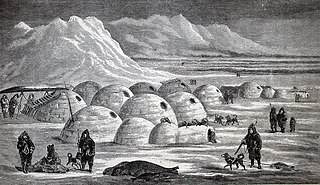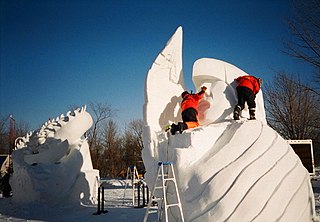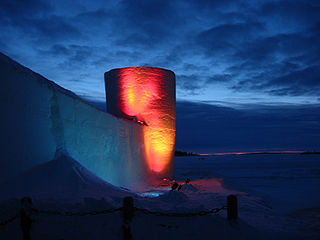
An igloo, also known as a snow house or snow hut, is a type of shelter built of suitable snow.

Sand art is the practice of modelling sand into an artistic form, such as sand brushing, sand sculpting, sand painting, or creating sand bottles. A sandcastle is a type of sand sculpture resembling a miniature building, often a castle. The drip castle variation uses wet sand that is dribbled down to form organic shapes before the sands dries.

The Sapporo Snow Festival is a festival held annually in Sapporo, Japan, over seven days in February. Odori Park, Susukino, and Tsudome are the main sites of the festival.

The Quebec Winter Carnival, commonly known in both English and French as Carnaval, is a pre-Lenten festival held in Quebec City. After being held intermittently since 1894, the Carnaval de Québec has been celebrated annually since 1955. That year, Bonhomme Carnaval, the mascot of the festival, made his first appearance. Up to one million people attended the Carnaval de Québec in 2006 making it, at the time, the largest winter festival in the world. It is, however, the largest winter festival in the Western Hemisphere.

Ice sculpture is a form of sculpture that uses ice as the raw material. Sculptures from ice can be abstract or realistic and can be functional or purely decorative. Ice sculptures are generally associated with special or extravagant events because of their limited lifetime.

An ice hotel is a temporary hotel made up of snow and sculpted blocks of ice. Ice hotels, dependent on sub-freezing temperatures, are constructed from ice and snow and typically have to be rebuilt every year. Ice hotels exist in several countries, and they have varying construction styles, services and amenities, the latter of which may include ice bars, restaurants, chapels, saunas and hot tubs.

Snow sculpture, snow carving or snow art is a sculpture form comparable to sand sculpture or ice sculpture in that most of it is now practiced outdoors often in full view of spectators, thus giving it kinship to performance art. The materials and the tools differ widely, but often include hand tools such as shovels, pickle forks, homemade tools, and saws. Snow sculptures are usually carved out of a single block of snow about 6–15 ft (1.8–4.6 m) on each side and weighing about 20–30 tons. The snow is densely packed into a form after having been produced by artificial means or collected from the ground after a snowfall.

A snow cave is a shelter constructed from snow by certain animals in the wild, human mountain climbers, winter recreational enthusiasts, and winter survivalists. It has thermal properties similar to an igloo and is particularly effective at providing protection from wind as well as low temperatures. A properly made snow cave can be 0 °C or warmer inside, even when outside temperatures are −40 °C.

The SnowCastle of Kemi is the biggest snow fort in the world. It is rebuilt every winter with a different architecture in Kemi, Finland. In 1996 the first snow castle drew 300,000 visitors. For several years the snowcastle was located in the Kemi city harbor. in 2017 the location was moved into a nearby park. Current address is Mansikkanokankatu 15.

The Snowking Winter Festival is an annual festival held each March in Yellowknife, Northwest Territories, Canada since 1996.

A quinzhee or quinzee is a Canadian snow shelter made from a large pile of loose snow that is shaped, then hollowed. This is in contrast to an igloo, which is built up from blocks of hard snow, and a snow cave, constructed by digging into the snow. The word is of Athabaskan origin and entered the English language by 1984. A quinzhee can be made for winter camping and survival purposes, or for fun.

The Northwest Territories Legislative Building is the home of the Legislative Assembly of the Northwest Territories, in Yellowknife, Northwest Territories. The territory's legislature has used many permanent and temporary facilities throughout its history. The most recent structure was built in 1993 and commenced usage in 1994, being officially opened that year by Canada's monarch, Queen Elizabeth II. Designed by Ferguson Simek Clark/Pin Matthews, in association with Matsuzaki Wright Architects Inc, the building is two stories tall and contains two round halls: the Great Hall and the Caucus Room. The grounds, overlooking Frame Lake, were laid out by Cornelia Oberlander.

Donald's Snow Fight is an animated short film featuring classic cartoon character Donald Duck in a snowball fight with his nephews Huey, Dewey and Louie. It was released in 1942 by Walt Disney Productions.
The Dog Who Stopped the War is a 1984 Canadian drama film directed by André Melançon. The film was the first in the Tales for All series of children's movies created by Les Productions la Fête.

A snowman is an anthropomorphic snow sculpture of a man often built in regions with sufficient snowfall and is a common winter tradition. In many places, typical snowmen consist of three large snowballs of different sizes with some additional accoutrements for facial and other features. Due to the sculptability of snow, there is also a wide variety of other styles. Common accessories include branches for arms and a smiley face made of stones, with a carrot used for a nose. Clothing, such as a hat or scarf, may be included. The low cost and common availability of materials mean snowmen are usually abandoned once completed.

The Icehotel is a hotel in northern Sweden, about 17 kilometers from Kiruna. It is rebuilt each year with snow and ice in the village of Jukkasjärvi and is the world's first ice hotel.

Snow Business is a provider of artificial snow for various entertainment industries. The company was founded by Darcey Crownshaw in 1982. Crownshaw was working in the paper industry when a production unit filming The Last Days of Pompeii for ABC-TV placed an order with his employers for three quarters of a ton of shredded grey cellulose paper to use as artificial volcanic ash. The firm would not deliver less than 20 tons so Crownshaw fulfilled the order himself using the padding from Jiffy bags. Crownshaw later supplied the same production unit with paper snow, and spotting a gap in the market established Snow Business.

Snowtime!, also released as La Bataille géante de boules de neige in France and Cleo in the United Kingdom, is a 2015 Canadian computer-animated comedy-drama film from Quebec. Directed by Jean-François Pouliot, it is an animated remake of the 1984 film The Dog Who Stopped the War.
Tom Turk and Daffy is a 1944 Warner Bros. Looney Tunes cartoon directed by Chuck Jones. The cartoon was released on February 12, 1944, and stars Porky Pig and Daffy Duck. Michael Maltese and Tedd Pierce are both the writers of the short, and are credited here as "The Staff".




















